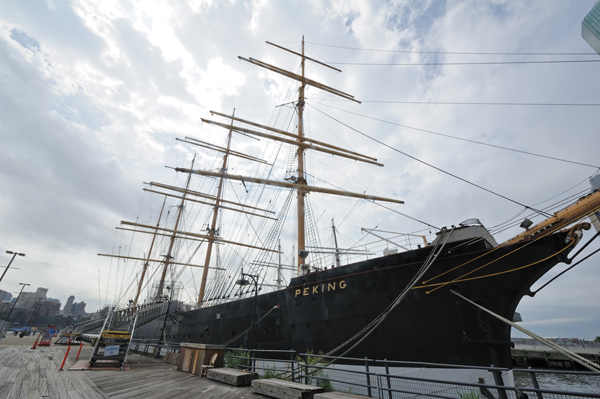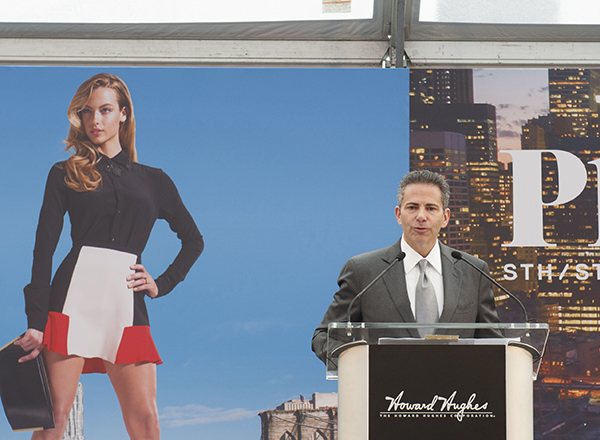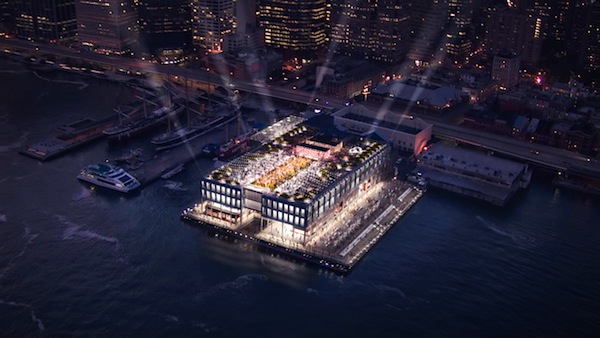
Downtown Express file photo by Terese Loeb Kreuzer.
By JOSH ROGERS with TERESE LOEB KREUZER | [Posted Oct. 17, 2013 and updated Oct. 18] Howard Hughes Corp. announced Thursday it has a general agreement with the city to take a larger role in running the cash-strapped South Street Seaport Museum.
“The mayor and I were just talking and we are both excited to share with you that there is an agreement in principle in place regarding the Seaport Museum,” David Weinreb, the firm’s C.E.O., said at an event attended by Mayor Mike Bloomberg. “There will be more to come on that in the coming weeks but we’ve got a very very exciting plan…It’s going to be dynamic and it’s a another great part of the experience that’s going to be created here.”
Weinreb made the remarks after the mayor was chided gently by Councilmember Margaret Chin for not mentioning the nearby museum at a symbolic groundbreaking event for the redevelopment of Pier 17 by Hughes Corp.
“I want to talk about the museum a little bit, and I didn’t hear the mayor say anything, but it is an important part of the Seaport, so I am really looking forward to the Howard Hughes Corp. supporting the Seaport Museum,” Chin said.
Some minutes later, the mayor leaned in to speak with Chin and Catherine McVay Hughes, chairperson of Community Board 1, and both women said it was to talk about the museum, which suffered extensive damage after Hurricane Sandy.
“Good news is coming,” Hughes, who has no connection to the development firm, told Downtown Express.
She was hoping to hear the full announcement about the museum at the Oct. 17 event, but remained hopeful it was coming soon.
Chin, who is also expecting good news, said she does not know the details but it will include finding a new operator for the museum and more.
The Seaport Museum had been run the last two years by the Museum of the City of New York, which received praise for its efforts, but it was unable to continue through this summer when there was still little hope of getting financial compensation soon for Sandy damage.
Both Weinreb and Chin said Kate Levin, the city’s commissioner of Cultural Affairs, was working hard to secure the museum’s future. The Hughes Corp. had previously dropped hints that it might be taking more control of the Seaport Museum, but the firm was reluctant to talk about it until now.
The news will undoubtedly be welcomed by some worried about the museum’s future, but with resistance from others already wary of Hughes’ large and expanding role in the neighborhood.
As for nearby Pier 17, it is expected to reopen in 2016 with many new features including 60,000 square feet of public open space on the roof, a 4,000-seat amphitheater, two outdoor bars and a revamped mall.
The project’s designer, Gregg Pasquarelli, a principal SHoP Architects, said the pier will have large glass doors, 32 by 20 feet, that will be opened in warm months to give the ground floor an outdoor feel.
He said the roof “will be one of the most magnificent views anywhere in New York of the Brooklyn Bridge.”
Hughes has also exercised its option to submit plans to develop the New Market Building, which is outside the city historic district, and the Tin Building.
The firm has begun private discussions with the city’s Economic Development Corp. about its plans for those two buildings.
Weinreb said the corporation has not made a final decision to try and build a mix of condos and a hotel as its predecessor once did, but he did sound like both those uses were likely.
“They [those uses] haven’t been locked down yet, but those are all things we are considering. … Our goal is to create a great district here in Lower Manhattan that truly leads to revitalization after Superstorm Sandy.”
Community Board 1 and Chin have been requesting for months that they be consulted before Hughes Corp. submits a formal land use application to develop the Tin and New Market sites, and outrage is growing on the board’s Seaport Committee, which passed a resolution this week asking for a seat at the table.
“Howard Hughes is coming here and walking all over a very small, precious community that frankly, if it were on Greenwich and Hudson St. [or other Tribeca streets]…it would be a completely different ballgame,” said member Jason Friedman, who accused the firm of “shady” dealings.
Amanda Byron Zink was one of the only people at the Oct. 15 meeting who came to the firm’s partial defense, saying the company has “extended a small olive branch” to small business owners like her on historic Front St.
“Do I still think there’s a dark horse,” Zink added. “Sure. Do I trust them 100 percent? No. Do I feel like they’re making some effort on some level? Yes.”
Howard Hughes hopes to create attractions for neighbors and other New Yorkers as well as for tourists.
It’s been an elusive goal which has plagued Seaport mall operators for three decades.
Bloomberg, who said Thursday that the Pier 17 project “will inject the Seaport with new life and fresh energy,” told Downtown Express back in 2005:
“Everybody thought that South Street Seaport would be the same as Faneuil Hall [in Boston] or Harbor Place in Baltimore [now both owned by Hughes Corp.] — it is not and the reason is, New York has throughout all five boroughs all of these stores, all of the excitement, the entertainment and everything. Having one area of just trendy stuff doesn’t sell in New York because there is no need.”




































